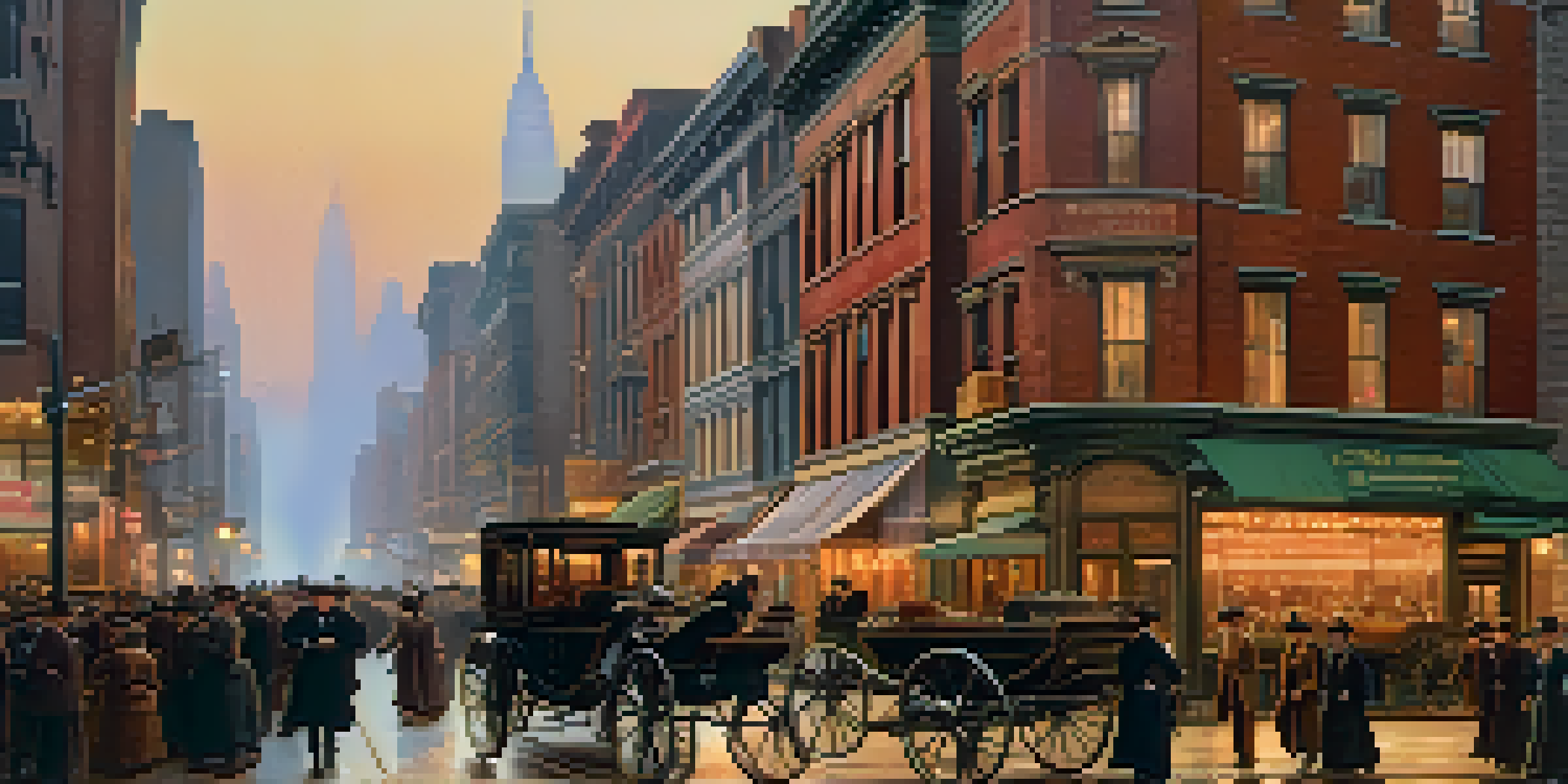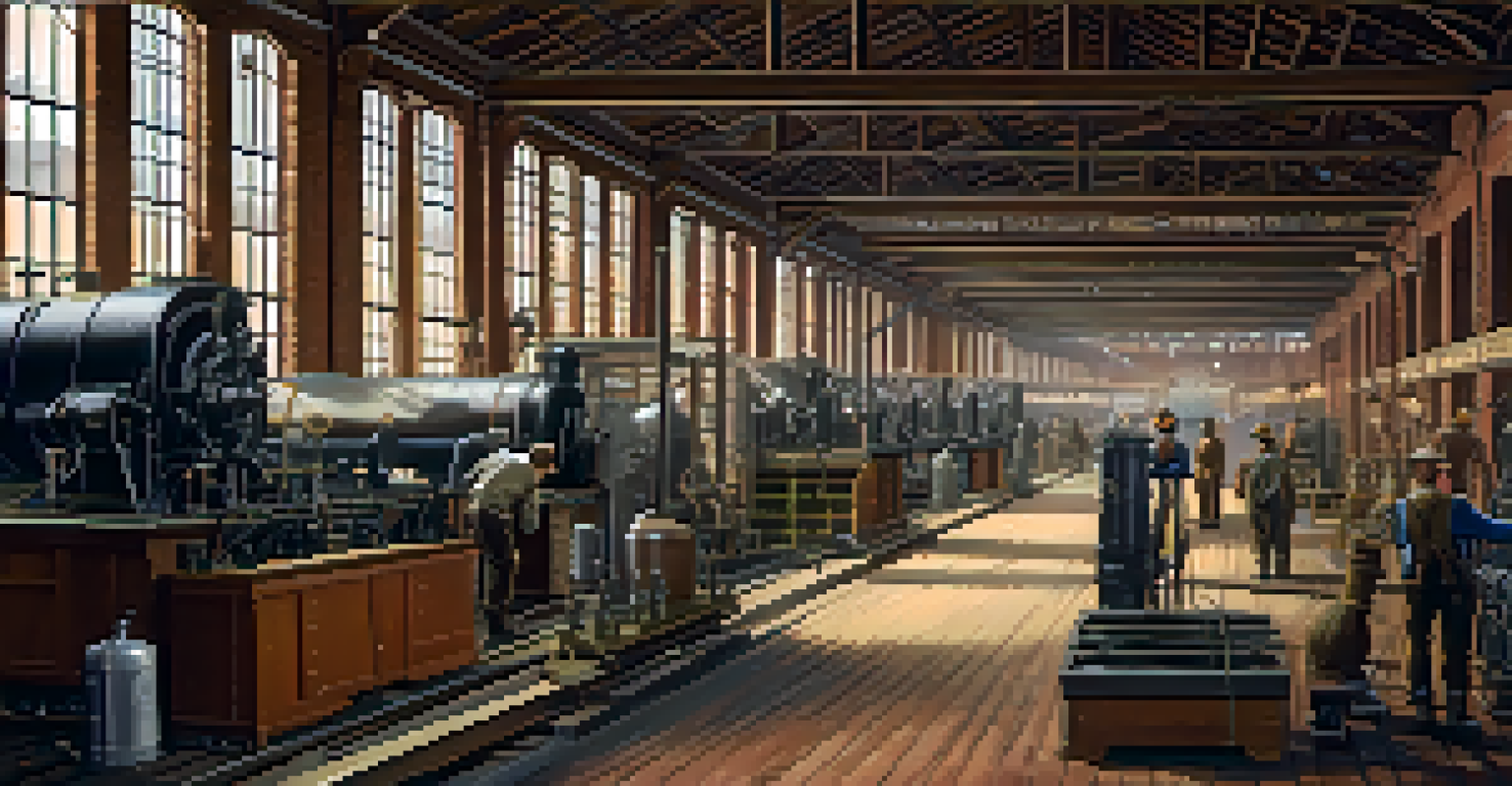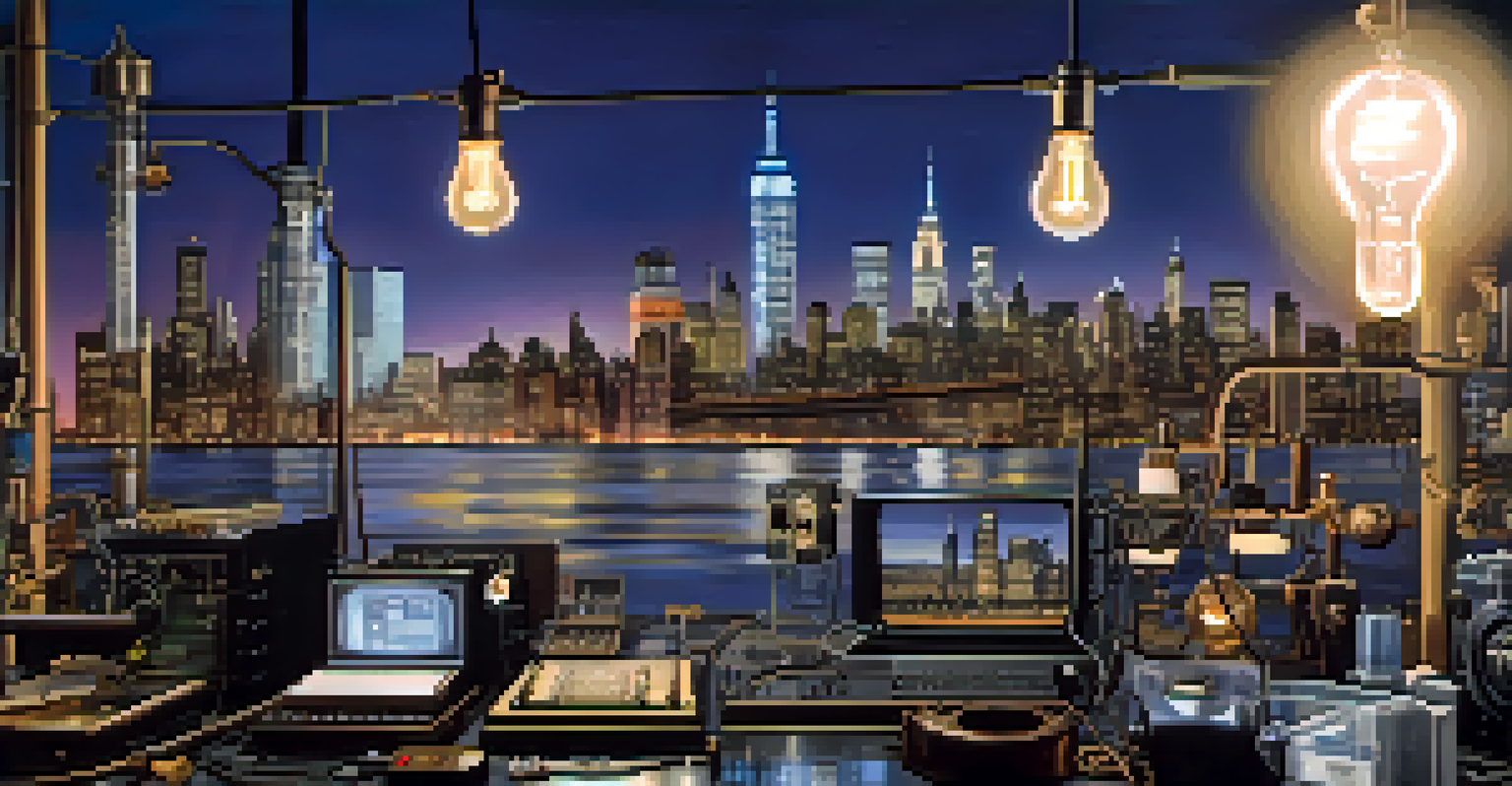The Impact of Thomas Edison on NYC's Technological Growth

Edison's Arrival and Initial Ventures in NYC
Thomas Edison arrived in New York City in the late 19th century, bringing with him a wave of innovation. His early ventures, including the establishment of the Edison Machine Works, set the stage for a technological revolution. This company focused on manufacturing electrical equipment, which was pivotal during a time when electricity was just beginning to illuminate the city.
Genius is one percent inspiration and ninety-nine percent perspiration.
Edison's presence in NYC wasn't just about business; it sparked a cultural shift towards embracing technology. His work drew the interest of investors and visionaries who saw the potential for electricity to transform urban life. This environment fostered collaboration and creativity, leading to a plethora of inventions that would change daily living.
Additionally, Edison's early achievements in telegraphy and electrical engineering laid the groundwork for what would become one of the most bustling technological hubs in the world. His ability to innovate and adapt attracted talented minds to the city, setting in motion a cycle of technological growth that would last for decades.
The Advent of Electric Light and Its Urban Impact
One of Edison's most significant contributions was the invention of the practical electric light bulb. Introduced in 1879, this groundbreaking technology transformed New York City from a dark, dangerous place into a vibrant hub of activity. The ability to light streets and homes extended the hours of productivity and leisure, changing the rhythm of city life.

Imagine bustling streets filled with pedestrians and horse-drawn carriages, all illuminated by Edison's electric lights. Businesses thrived as they stayed open longer, and social life flourished in the evenings. This shift not only enhanced safety but also fostered a sense of community as people gathered in well-lit public spaces.
Edison's Innovations Sparked Change
Thomas Edison's arrival in NYC initiated a technological revolution that transformed urban life and fostered a culture of innovation.
Moreover, the electric light bulb paved the way for further advancements in electrical infrastructure. As more buildings and businesses adopted electric lighting, the demand for electricity surged, leading to the establishment of power plants. Edison's innovations thus laid the foundation for an entire industry, propelling NYC into a new era of technological advancement.
Edison's Role in Developing Electrical Infrastructure
Edison's vision extended beyond just the light bulb; he was instrumental in creating the electrical infrastructure that supported it. He established the first commercial power station, the Pearl Street Station, in 1882, which provided electricity to a small section of Manhattan. This was a monumental leap in making electricity accessible to the masses.
I have not failed. I've just found 10,000 ways that won't work.
The success of the Pearl Street Station demonstrated the feasibility of electricity as a reliable energy source for urban environments. Edison's model inspired other cities to develop similar systems, leading to a nationwide push for electrification. This movement not only changed the way people lived but also influenced industries ranging from manufacturing to transportation.
As the demand for electricity grew, so did the complexity of the infrastructure required to support it. Edison's early innovations prompted advancements in technology that enabled the distribution of power over greater distances, ultimately shaping the modern electrical grid we rely on today. His work created a legacy of innovation that would define New York City's technological landscape.
Edison and the Rise of New Industries
With the introduction of electric power, new industries began to flourish in NYC, transforming the economic landscape. Edison's inventions catalyzed growth in sectors such as telecommunications, manufacturing, and even entertainment. For instance, the ability to power machinery led to increased production capabilities, allowing businesses to expand rapidly.
Moreover, Edison's work with sound recording and motion pictures laid the groundwork for the entertainment industry. His invention of the phonograph in 1877 and later contributions to early film technology turned NYC into a hub for creative arts. This shift not only provided jobs but also positioned the city as a cultural beacon.
Electric Light Revolutionized NYC
The introduction of the practical electric light bulb not only illuminated the city but also extended productivity and social life into the evening.
The convergence of technology and industry sparked a wave of entrepreneurship, with inventors and business owners flocking to NYC to capitalize on the electric revolution. Edison's influence was a key driver in transforming the city into a bustling metropolis where innovation thrived and new ideas took flight.
The Influence of Edison's Patents on Innovation
Edison's extensive portfolio of patents played a significant role in shaping innovation in New York City. With over 1,000 patents to his name, he not only protected his inventions but also set a standard for intellectual property rights in the tech industry. This encouraged other inventors to pursue their ideas, knowing they could safeguard their work.
Edison's patents covered a wide range of technologies, from electrical systems to recording devices. This breadth fostered an environment where interdisciplinary collaboration became commonplace, and ideas flowed freely between industries. As a result, many groundbreaking inventions emerged from this fertile ground of creativity.
Moreover, Edison's approach to research and development, which included systematic experimentation and iteration, influenced how innovation was pursued in NYC. His model of creating laboratories and employing teams of skilled workers became a blueprint for future inventors and companies, solidifying the city’s reputation as a center for technological advancement.
Edison's Legacy in Education and Research
Edison's impact extended beyond inventions; he also contributed to the educational landscape of NYC. His belief in the power of learning led to the establishment of various educational institutions focused on science and technology. These schools nurtured future generations of innovators who would continue his legacy.
In addition to formal education, Edison emphasized the importance of hands-on experience. He often advocated for apprenticeships and practical training, encouraging young minds to engage directly with technology. This approach not only equipped students with skills but also instilled a sense of creativity and curiosity.
Legacy of Education and Research
Edison's influence led to the establishment of educational institutions that nurtured future innovators, ensuring the continuation of his legacy.
As a result of Edison's influence, cities like New York began to see a rise in technical schools and research institutions. These establishments became breeding grounds for future inventions and technological advancements, creating a cycle of innovation that has continued to this day. Edison's legacy lives on through the countless individuals inspired by his vision and work.
Edison's Lasting Impact on Modern NYC
Today, New York City stands as a testament to Edison's contributions, with a skyline that reflects a century of innovation. The technological advancements he pioneered laid the groundwork for the digital age, influencing everything from infrastructure to entertainment. His legacy is evident in the city's ongoing commitment to innovation and technology.
Moreover, Edison's influence can be seen in the thriving startup culture that has emerged in NYC. Entrepreneurs continue to draw inspiration from his spirit of invention, pushing boundaries and creating new technologies that shape our world. The city's vibrant tech scene echoes the dynamism that Edison brought to the forefront over a century ago.

In essence, Thomas Edison's impact on New York City transcends his inventions; it embodies a culture of innovation that continues to evolve. As we look to the future, we can appreciate how one man's vision transformed a city and, ultimately, the world.